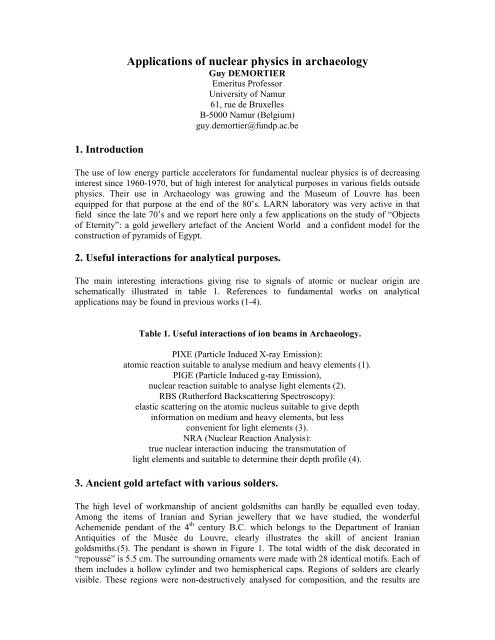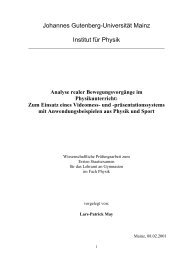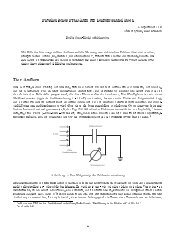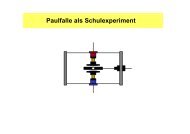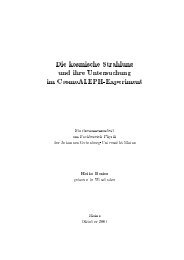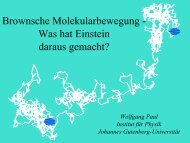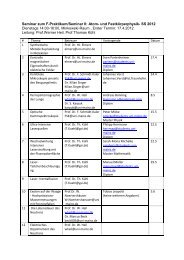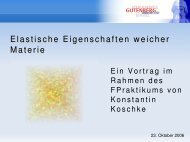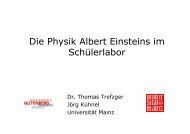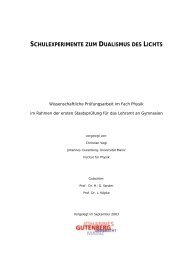Applications of nuclear physics in archaeology
Applications of nuclear physics in archaeology
Applications of nuclear physics in archaeology
Create successful ePaper yourself
Turn your PDF publications into a flip-book with our unique Google optimized e-Paper software.
1. Introduction<br />
<strong>Applications</strong> <strong>of</strong> <strong>nuclear</strong> <strong>physics</strong> <strong>in</strong> <strong>archaeology</strong><br />
Guy DEMORTIER<br />
Emeritus Pr<strong>of</strong>essor<br />
University <strong>of</strong> Namur<br />
61, rue de Bruxelles<br />
B-5000 Namur (Belgium)<br />
guy.demortier@fundp.ac.be<br />
The use <strong>of</strong> low energy particle accelerators for fundamental <strong>nuclear</strong> <strong>physics</strong> is <strong>of</strong> decreas<strong>in</strong>g<br />
<strong>in</strong>terest s<strong>in</strong>ce 1960-1970, but <strong>of</strong> high <strong>in</strong>terest for analytical purposes <strong>in</strong> various fields outside<br />
<strong>physics</strong>. Their use <strong>in</strong> Archaeology was grow<strong>in</strong>g and the Museum <strong>of</strong> Louvre has been<br />
equipped for that purpose at the end <strong>of</strong> the 80’s. LARN laboratory was very active <strong>in</strong> that<br />
field s<strong>in</strong>ce the late 70’s and we report here only a few applications on the study <strong>of</strong> “Objects<br />
<strong>of</strong> Eternity”: a gold jewellery artefact <strong>of</strong> the Ancient World and a confident model for the<br />
construction <strong>of</strong> pyramids <strong>of</strong> Egypt.<br />
2. Useful <strong>in</strong>teractions for analytical purposes.<br />
The ma<strong>in</strong> <strong>in</strong>terest<strong>in</strong>g <strong>in</strong>teractions giv<strong>in</strong>g rise to signals <strong>of</strong> atomic or <strong>nuclear</strong> orig<strong>in</strong> are<br />
schematically illustrated <strong>in</strong> table 1. References to fundamental works on analytical<br />
applications may be found <strong>in</strong> previous works (1-4).<br />
Table 1. Useful <strong>in</strong>teractions <strong>of</strong> ion beams <strong>in</strong> Archaeology.<br />
PIXE (Particle Induced X-ray Emission):<br />
atomic reaction suitable to analyse medium and heavy elements (1).<br />
PIGE (Particle Induced g-ray Emission),<br />
<strong>nuclear</strong> reaction suitable to analyse light elements (2).<br />
RBS (Rutherford Backscatter<strong>in</strong>g Spectroscopy):<br />
elastic scatter<strong>in</strong>g on the atomic nucleus suitable to give depth<br />
<strong>in</strong>formation on medium and heavy elements, but less<br />
convenient for light elements (3).<br />
NRA (Nuclear Reaction Analysis):<br />
true <strong>nuclear</strong> <strong>in</strong>teraction <strong>in</strong>duc<strong>in</strong>g the transmutation <strong>of</strong><br />
light elements and suitable to determ<strong>in</strong>e their depth pr<strong>of</strong>ile (4).<br />
3. Ancient gold artefact with various solders.<br />
The high level <strong>of</strong> workmanship <strong>of</strong> ancient goldsmiths can hardly be equalled even today.<br />
Among the items <strong>of</strong> Iranian and Syrian jewellery that we have studied, the wonderful<br />
Achemenide pendant <strong>of</strong> the 4 th century B.C. which belongs to the Department <strong>of</strong> Iranian<br />
Antiquities <strong>of</strong> the Musée du Louvre, clearly illustrates the skill <strong>of</strong> ancient Iranian<br />
goldsmiths.(5). The pendant is shown <strong>in</strong> Figure 1. The total width <strong>of</strong> the disk decorated <strong>in</strong><br />
“repoussé” is 5.5 cm. The surround<strong>in</strong>g ornaments were made with 28 identical motifs. Each <strong>of</strong><br />
them <strong>in</strong>cludes a hollow cyl<strong>in</strong>der and two hemispherical caps. Regions <strong>of</strong> solders are clearly<br />
visible. These regions were non-destructively analysed for composition, and the results are
summarised <strong>in</strong> figure 2. All measurements have been performed with proton-<strong>in</strong>duced X-ray<br />
emission (PIXE) <strong>in</strong> a microprobe assembly. A PIXE microprobe facility has been used to<br />
irradiate small regions (15 µm wide) <strong>of</strong> the sample put <strong>in</strong> a vacuum chamber. The pendant<br />
was fixed on an X-Y frame and moved <strong>in</strong> the proton beam by stepp<strong>in</strong>g motors with a<br />
reproducibility better than 2.5 microns. Four jo<strong>in</strong>s were made from regions A to D <strong>of</strong> Figure<br />
2, over a distance extend<strong>in</strong>g less than 5 mm. The elemental composition at solders (impacts <strong>in</strong><br />
regions A, B, C and D) shows that three different jo<strong>in</strong><strong>in</strong>g procedures were performed. At site<br />
C, the gold content is significantly greater than <strong>in</strong> the neighbour<strong>in</strong>g regions and <strong>in</strong>dicates that<br />
the jo<strong>in</strong> was made by weld<strong>in</strong>g without add<strong>in</strong>g any external material: the end <strong>of</strong> the cyl<strong>in</strong>der<br />
and the bottom <strong>of</strong> the first hemispherical cap were simultaneously heated to an early stage <strong>of</strong><br />
fusion. In this process, metals like copper and silver were selectively elim<strong>in</strong>ated, ma<strong>in</strong>ly by<br />
oxidation, so that the gold content was enhanced. The temperature was around 1050°C.<br />
At site D, an <strong>in</strong>crease <strong>in</strong> copper concentration was observed simultaneously with a<br />
proportional decrease <strong>in</strong> gold and silver concentrations. The two caps, previously well-fitted<br />
were jo<strong>in</strong>ed by the process known as solid-state diffusion bond<strong>in</strong>g with copper salts <strong>in</strong> a<br />
reduc<strong>in</strong>g atmosphere. The process took place at about 890°C . This relatively low temperature<br />
makes the jo<strong>in</strong><strong>in</strong>g at site D without de-solder<strong>in</strong>g the jo<strong>in</strong> at site C, only 1.5 mm distant. This<br />
jo<strong>in</strong><strong>in</strong>g method was widely used by the Etruscans <strong>in</strong> their famous granulation work.<br />
An <strong>in</strong>crease <strong>in</strong> copper and silver and a decrease <strong>in</strong> gold were simultaneously observed at sites<br />
A and B, a result <strong>in</strong>dicat<strong>in</strong>g that at both sites a braz<strong>in</strong>g alloy has been used. The lower<br />
concentration <strong>of</strong> gold <strong>in</strong> region A <strong>in</strong>dicated that the temperature <strong>of</strong> fusion <strong>of</strong> the alloy used at<br />
that site was lower than that used at site B (possibly around 820 and 860°C respectively).<br />
These temperatures are close to 890°: the solder<strong>in</strong>g temperature at site D. However, the latter<br />
jo<strong>in</strong> did not desolder. The process <strong>of</strong> diffusion bond<strong>in</strong>g produces a jo<strong>in</strong> that cannot be desoldered.<br />
Reheat<strong>in</strong>g after jo<strong>in</strong><strong>in</strong>g results <strong>in</strong> further copper diffusion. That diffusion <strong>in</strong>duces a<br />
local decrease <strong>of</strong> the copper content with a consequent <strong>in</strong>crease <strong>in</strong> the local melt<strong>in</strong>g<br />
temperature. The high degree <strong>of</strong> workmanship displayed <strong>in</strong> a piece as complex as the<br />
Achemenide pendant shows that, 2500 years ago, the goldsmith recognized and used different<br />
temperatures for various jo<strong>in</strong><strong>in</strong>g processes.<br />
This process <strong>of</strong> solder<strong>in</strong>g was easily reproduced <strong>in</strong> our laboratory. Natural malachite was<br />
f<strong>in</strong>ely powdered and mixed with some fat. The mixture was spread on a sheet <strong>of</strong> pure gold<br />
which was then covered with another gold piece. The whole assembly was heated <strong>in</strong> order to<br />
<strong>in</strong>duce the reduction <strong>of</strong> malachite with carbon from the burned fat and to allow copper to<br />
diffuse <strong>in</strong> both parts <strong>of</strong> the system to ensure the bond<strong>in</strong>g. A modern improvement <strong>of</strong> this<br />
process <strong>of</strong> bond<strong>in</strong>g has been experimented us<strong>in</strong>g the formation <strong>of</strong> a low melt<strong>in</strong>g po<strong>in</strong>t gold<br />
b<strong>in</strong>ary alloy: the eutectic bond<strong>in</strong>g with Au-Si (6).<br />
4. From Etruscan solid state bond<strong>in</strong>g to modern eutectic bound<strong>in</strong>g.<br />
Silicon alloyed with gold may form a eutectic alloy which can be used as a low melt<strong>in</strong>g po<strong>in</strong>t<br />
solder. We have experimented with a new process <strong>of</strong> gold solder<strong>in</strong>g <strong>in</strong>volv<strong>in</strong>g two steps: (a)<br />
the formation <strong>of</strong> a microscopic gold-silicon eutectic alloy dur<strong>in</strong>g silicon diffusion through<br />
polycrystall<strong>in</strong>e gold foils along their gra<strong>in</strong> boundaries and the re-diffusion <strong>of</strong> a part <strong>of</strong> this<br />
eutectic alloy to form the jo<strong>in</strong><strong>in</strong>g with a second pure gold element. Both steps are performed<br />
at a low temperature (below 400°C).<br />
Particle-<strong>in</strong>duced-X-ray emission (PIXE) and <strong>nuclear</strong> reactions (NR) <strong>in</strong>duced by a deuteron<br />
microbeam have been used to characterize the gold-silicon alloy formed by the diffusion <strong>of</strong><br />
silicon <strong>in</strong>to gold foils.<br />
Pure polycrystall<strong>in</strong>e gold foils are rolled at room temperature down to thicknesses rang<strong>in</strong>g<br />
from 10 to 20 µm. A film <strong>of</strong> silicon is then deposited through a mask on a part <strong>of</strong> these foils
with an electron gun. As the adherence <strong>of</strong> silicon on gold is extremely difficult at room<br />
temperature, gold foils are ma<strong>in</strong>ta<strong>in</strong>ed at 400°C dur<strong>in</strong>g the silicon deposition. This<br />
temperature is slightly higher than the eutectic temperature (363°C) so that any Au-Si mixture<br />
at 400°C always conta<strong>in</strong>s a liquid phase. This liquid rapidly diffuses <strong>in</strong> the gold foils, but only<br />
along well-def<strong>in</strong>ed paths: the gold gra<strong>in</strong> boundaries.<br />
Nuclear reaction <strong>in</strong>duced by deuterons giv<strong>in</strong>g rise to proton emission is used to measure the<br />
3D distribution <strong>of</strong> silicon <strong>in</strong> gold. Deuterons can scarcely hit or graze a light nucleus (like Si)<br />
and be stripped, lead<strong>in</strong>g to the capture <strong>of</strong> the neutron and the emission <strong>of</strong> the residual proton<br />
(stripp<strong>in</strong>g reactions). This <strong>nuclear</strong> reaction on silicon is highly exoenergetic (Q = 6.249 MeV)<br />
due to greater b<strong>in</strong>d<strong>in</strong>g energy <strong>of</strong> the exchanged neutron with the silicon nucleus by<br />
comparison with that <strong>in</strong>to the deuteron. This <strong>nuclear</strong> reaction <strong>in</strong>volv<strong>in</strong>g the neutron capture to<br />
leave the f<strong>in</strong>al residual nucleus <strong>in</strong> its fundamental state has its maximum <strong>in</strong>tensity if the<br />
proton emission is achieved <strong>in</strong> the forward direction. We have then chosen to detect the<br />
emitted protons <strong>in</strong> the forward direction. A 25 µm thick absorber <strong>of</strong> pure gold is <strong>in</strong>serted<br />
between the sample to be studied and the detector, <strong>in</strong> order to completely stop the <strong>in</strong>cident<br />
deuteron beam. The choice <strong>of</strong> a material conta<strong>in</strong><strong>in</strong>g only a heavy element as absorber prevents<br />
any emission <strong>of</strong> additional protons. On account <strong>of</strong> the low cross section <strong>of</strong> <strong>nuclear</strong> reactions<br />
<strong>in</strong>duced by low <strong>in</strong>tensity microbeam, the sensitivity for silicon determ<strong>in</strong>ation <strong>in</strong> volumes <strong>of</strong><br />
30 µm 3 lies around 0.5%.The experimental procedure is illustrated <strong>in</strong> figure 3. The results <strong>of</strong><br />
figure 4 have been obta<strong>in</strong>ed on a gold foil <strong>of</strong> 12 µm thick irradiated by 2.8 MeV deuterons<br />
<strong>in</strong>cident on the back side <strong>of</strong> the foil prepared by silicon diffusion (the side opposite that on<br />
which silicon has been deposited). The first map (on the left) corresponds to the front surface<br />
<strong>of</strong> the foil (that on which silicon has been deposited). The last one corresponds to the silicon<br />
concentration at the rear, 12 µm below. (7).<br />
With the same experimental arrangement for the analysis and the same experimental<br />
procedure (analysis followed by the reproduction <strong>of</strong> the process <strong>in</strong> our laboratory) we may<br />
propose a confident mode <strong>of</strong> construction <strong>of</strong> several Egyptian pyramids.<br />
5. The composition <strong>of</strong> the pyramid <strong>of</strong> Kheops .<br />
The Cheops' pyramid, with a volume <strong>of</strong> 2.7 10 6 m 3 , was completed over a period <strong>of</strong> 20 to 25<br />
years. One can then estimate the average daily cadence at 300 to 400 blocks hav<strong>in</strong>g all an<br />
average volume <strong>of</strong> 1 m 3 (i.e. 750 to 1000 tons per day). This represents one block put at the<br />
right place every two m<strong>in</strong>utes. To achieve this goal, 1 m 2 <strong>of</strong> hewn face would have been ready<br />
every 20 seconds! What a performance with tools made <strong>of</strong> stone or s<strong>of</strong>t copper! Hoist<strong>in</strong>g huge<br />
blocks <strong>of</strong> more than two tons with rudimentary means (wheels and pulleys did not exist at that<br />
time) is evidently an impossible task. As several dozens <strong>of</strong> those monuments have been<br />
constructed on the left bank <strong>of</strong> the Nile by the Pharaohs <strong>of</strong> the first dynasties, we cannot<br />
imag<strong>in</strong>e the average time <strong>of</strong> construction <strong>of</strong> each pyramid to be much longer. When look<strong>in</strong>g<br />
carefully at the surface <strong>of</strong> the blocks <strong>of</strong> the pyramid <strong>of</strong> Kheops (those visible today and<br />
therefore those underly<strong>in</strong>g the cas<strong>in</strong>g blocks, which totally disappeared), one clearly sees<br />
irregularity <strong>in</strong> the shape, but a remarkable close fit <strong>of</strong> adjacent faces. It would be surpris<strong>in</strong>g<br />
that these blocks could have been so badly cut but so perfectly jo<strong>in</strong>ed. This admirable close fit<br />
would have been easier to achieve if the blocks had been hewn with perfect rectangular<br />
shapes! Furthermore, this care <strong>in</strong> this optimal juxtaposition was useless because these blocks<br />
(visible today) were orig<strong>in</strong>ally hidden under the cas<strong>in</strong>g. We can also see that blocks appear to<br />
be more porous <strong>in</strong> their top part than <strong>in</strong> their bottom part. This porous feature on the top <strong>of</strong> the<br />
blocks cannot be expla<strong>in</strong>ed by some climatic erosion <strong>of</strong> natural limestone but could be<br />
understood if we propose a construction similar to our modern concrete.
Narrow channels, with a section <strong>of</strong> 20 cm x 20 cm, start<strong>in</strong>g from the Queen's chamber and<br />
<strong>in</strong>vestigated by R.Gantenbl<strong>in</strong>k's robot (8) clearly <strong>in</strong>dicate that they were not carved . There is<br />
no gap between the two lateral sides (walls) and the ceil<strong>in</strong>g <strong>of</strong> this conduit. On a TV show <strong>of</strong><br />
the Gantenbl<strong>in</strong>k's expedition, one could see that no protrude (convex) defect appears <strong>in</strong> the<br />
walls and <strong>in</strong> the ceil<strong>in</strong>g <strong>of</strong> this narrow tunnel. Irregularities are only <strong>of</strong> hollow (concave)<br />
shapes. A carv<strong>in</strong>g procedure would have given convex and concave irregularities <strong>in</strong> equal<br />
proportions. When th<strong>in</strong>k<strong>in</strong>g about a mould<strong>in</strong>g procedure, the apparent cavities could be<br />
understood by some loss <strong>of</strong> material dur<strong>in</strong>g the de-mould<strong>in</strong>g.<br />
Many other arguments <strong>in</strong>clud<strong>in</strong>g (a) the chaotic organisation <strong>of</strong> nummulites <strong>in</strong> the blocks,<br />
with respect to parallel alignment <strong>of</strong> shells <strong>in</strong> natural stones, (b) the high water content (about<br />
13%) <strong>of</strong> the whole pyramid measured by the transmission <strong>of</strong> electromagnetic waves, (c) traces<br />
<strong>of</strong> mortar mostly at the base <strong>of</strong> the blocks, play <strong>in</strong> favour <strong>of</strong> another way <strong>of</strong> construction: not<br />
natural hewn and hoisted stones but the agglomeration <strong>of</strong> natural limestone us<strong>in</strong>g a b<strong>in</strong>der …<br />
which conta<strong>in</strong>s natron, alum<strong>in</strong>o-silicates and certa<strong>in</strong>ly water. All <strong>in</strong>gredients have been<br />
transported <strong>in</strong> small quantities, dropped <strong>in</strong> moulds <strong>in</strong>stalled progressively onto or on the side<br />
<strong>of</strong> blocks which were previously moulded.<br />
In the 70’s, J.Davidovits (9) proposed that the great pyramids were made <strong>of</strong> a k<strong>in</strong>d <strong>of</strong> concrete<br />
whose basic b<strong>in</strong>d<strong>in</strong>g element was natron: a sodium carbonate. Natron was <strong>in</strong>deed widely<br />
extracted from a region <strong>of</strong> the North <strong>of</strong> Egypt, on the left bank <strong>of</strong> the Nile, very close to the<br />
site <strong>of</strong> Giza. The b<strong>in</strong>der is obta<strong>in</strong>ed by some chemical reaction giv<strong>in</strong>g rise to a geopolymer<br />
(name given by Davidovits to a class <strong>of</strong> X-polysialates, X be<strong>in</strong>g an alkal<strong>in</strong>e nucleus, <strong>in</strong><br />
particular sodium). Natron, lime and water form caustic soda, which reacts with alum<strong>in</strong>ous<br />
limestone to yield the basic geopolymer. A m<strong>in</strong>eral ore conta<strong>in</strong><strong>in</strong>g arsenic (scorodite or<br />
olivenite) is added to produce sodium arsenate act<strong>in</strong>g as an activat<strong>in</strong>g <strong>in</strong>gredient that could<br />
have been used <strong>in</strong> various concentrations to control the speed <strong>of</strong> the hydraulic sett<strong>in</strong>g. The<br />
<strong>in</strong>vention is attributed to Imhotep, the architect <strong>of</strong> the pyramid <strong>of</strong> the Pharaoh Djeser.<br />
In addition to the analyses carried out by J. Davidovits with X-ray fluorescence (9) and X-ray<br />
diffraction, which showed that the blocks ma<strong>in</strong>ly consisted <strong>of</strong> limestone (85 to 92%), we have<br />
also performed <strong>in</strong>vestigations on a little number <strong>of</strong> samples from the Kheops' pyramid:<br />
elemental analysis was performed by ion beam analyses, PIXE and PIGE and structural<br />
characterization by NMR-Spectroscopy. (10 - 11)<br />
By us<strong>in</strong>g the PIGE-PIXE techniques (Proton Induced Gamma-ray Emission or X-ray<br />
Emission) we have determ<strong>in</strong>ed the elemental content <strong>of</strong> small fragments. The light elements<br />
F, Na, Mg, Al, Si were quantitatively determ<strong>in</strong>ed by us<strong>in</strong>g PIGE , and Ca, Fe and other trace<br />
elements by us<strong>in</strong>g PIXE (11). A small sample from the Kheop's pyramid (figure 5) is made <strong>of</strong><br />
a central compact structure conta<strong>in</strong><strong>in</strong>g ma<strong>in</strong>ly limestone with traces <strong>of</strong> other elements The<br />
outer part conta<strong>in</strong>s a large amount <strong>of</strong> F, Na, Mg, Al, Si, <strong>in</strong>dicat<strong>in</strong>g that a material to aggregate<br />
the limestone has been used . The ratios <strong>of</strong> concentrations <strong>of</strong> F, Na, Mg, Al and Si <strong>in</strong> the<br />
coat<strong>in</strong>g relative to the bulk are given <strong>in</strong> Table 2.<br />
Table 2<br />
Intensity radios (coat<strong>in</strong>g/bulk)<br />
F 7.5<br />
Na 8.5<br />
Mg 12<br />
Al 2<br />
Si 21
Except for Al, those ratios are much more greater than one, <strong>in</strong>dicat<strong>in</strong>g a complete different<br />
structure. The high concentration <strong>of</strong> sodium is certa<strong>in</strong>ly due to the use <strong>of</strong> natron for the<br />
b<strong>in</strong>der. Furthermore, the significant signal <strong>of</strong> As <strong>in</strong> the coat<strong>in</strong>g may be attributed to some<br />
additional ore which could be scorodite as more extensively discussed below. In addition to<br />
PIGE and PIXE measurements which allow us to have <strong>in</strong>sight to the elemental composition,<br />
the Nuclear Magnetic Resonance Spectroscopy (NMR) <strong>of</strong> Al 27 and Si 29 enables us to<br />
determ<strong>in</strong>e the type <strong>of</strong> synthetic medium (basic pH) and to differentiate a natural environment<br />
(neutral pH) from an artificial one. We have then fabricated the b<strong>in</strong>der based on the<br />
geopolymer formula <strong>of</strong> J.Davidovits (9). The NMR-Spectra <strong>of</strong> Al and Si on this modern<br />
synthetic material shows typical resonances assigned to Si [Si(OSi) 4 ] and Al (tetrahedral) <strong>in</strong><br />
this synthesized material which is highly chemically basic (pH around 10). The NMR spectra<br />
<strong>of</strong> several samples <strong>of</strong> Kheops pyramid <strong>in</strong>dicate that the tetrahedral Al content is 10-15% <strong>of</strong><br />
that obta<strong>in</strong>ed for the pure synthetic mixture reproduced <strong>in</strong> our laboratory and which exhibits a<br />
very f<strong>in</strong>e adherence with small gravels. This value <strong>of</strong> 10-15% <strong>of</strong> the NMR signals is <strong>in</strong> direct<br />
relation with the amount <strong>of</strong> geopolymeric b<strong>in</strong>der and, consequently, also related to the<br />
orig<strong>in</strong>al water content <strong>of</strong> the blocks. Si-NMR leads to the same conclusion.<br />
6. Manpower for the construction <strong>of</strong> the pyramid.<br />
The moulds could have been made <strong>of</strong> grooved small boards fitt<strong>in</strong>g one <strong>in</strong>to the other <strong>in</strong> the<br />
way <strong>of</strong> modern wooden floors. The fixation by two crossbars <strong>of</strong> the first and <strong>of</strong> the last small<br />
board <strong>of</strong> the mould (and only these two boards), as represented <strong>in</strong> figure 6 , allows the<br />
<strong>in</strong>termediate small planks to slide <strong>in</strong> a movement go<strong>in</strong>g from the top downwards to prevent<br />
any leakage <strong>in</strong> the region <strong>of</strong> contact with the block <strong>of</strong> the <strong>in</strong>ferior step. These small boards<br />
have probably the width <strong>of</strong> an Egyptian palm (1/7 <strong>of</strong> cubit, about 7.5 cm). The construction <strong>of</strong><br />
the moulds with a def<strong>in</strong>ite number <strong>of</strong> small boards expla<strong>in</strong>s the modular width reported by<br />
Davidovits for the blocks <strong>of</strong> -'s pyramid. Davidovits mentioned this modular dimension (an<br />
<strong>in</strong>teger <strong>of</strong> a reference board width) for the blocks <strong>of</strong> Khephren and not those <strong>of</strong> Kheops<br />
because blocks <strong>of</strong> Khephren have a more regular dimension. This second pyramid <strong>of</strong> Giza<br />
would have pr<strong>of</strong>ited from the experience acquired dur<strong>in</strong>g the construction <strong>of</strong> the first pyramid<br />
at Giza: the Kheops pyramid. Those blocks <strong>of</strong> Khephren have then a higher quality <strong>in</strong> their<br />
f<strong>in</strong>ish.<br />
The irregularity noticed on the blocks <strong>in</strong> the Kheops pyramid would be due to possible<br />
"accidents" dur<strong>in</strong>g the remov<strong>in</strong>g <strong>of</strong> the planks <strong>of</strong> the mould after the solidification <strong>of</strong> the<br />
liquid b<strong>in</strong>der. Any loss <strong>of</strong> build<strong>in</strong>g material occurr<strong>in</strong>g dur<strong>in</strong>g de-mould<strong>in</strong>g would have been<br />
corrected by a partial cover<strong>in</strong>g <strong>of</strong> the de-moulded block with the next mould. With this<br />
method, the harden<strong>in</strong>g <strong>of</strong> the new block provided a close fit with the precedent, even though<br />
this last one had lost its surface regularity dur<strong>in</strong>g the de-mould<strong>in</strong>g.<br />
A system <strong>of</strong> two boards constituted <strong>of</strong> a variable number <strong>of</strong> one palm wide small planks was<br />
sufficient for the constitution <strong>of</strong> a mould: the lower blocks, the side blocks and the leaned<br />
blocks provide the other four faces that <strong>in</strong>sure the tightness <strong>of</strong> the volume <strong>in</strong> which the<br />
mixture is poured. This procedure expla<strong>in</strong>s the modularity noticed for the widths <strong>of</strong> all the<br />
blocks <strong>in</strong> Khephren's pyramid and also the close fit between the irregular blocks <strong>in</strong> the<br />
pyramids <strong>of</strong> Giza, even the one <strong>of</strong> Kheops. The height <strong>of</strong> a s<strong>in</strong>gle block depends on the height<br />
<strong>of</strong> the shortest plank used <strong>in</strong> for mould. The modular width <strong>of</strong> the blocks <strong>of</strong> the Khephren’s<br />
pyramid depends on the number <strong>of</strong> small planks constitut<strong>in</strong>g the board.<br />
The solid <strong>in</strong>gredients brought <strong>in</strong> bow nets are poured <strong>in</strong>to the mould that has been made<br />
waterpro<strong>of</strong> by the application <strong>of</strong> a mortar. This mortar is applied to the <strong>in</strong>ternal base <strong>of</strong> the<br />
mould. The mortar, already visible today, is ma<strong>in</strong>ly present at the base <strong>of</strong> the blocks. As for<br />
mould<strong>in</strong>g a block, liquid <strong>in</strong>gredients are first poured, waterpro<strong>of</strong><strong>in</strong>g is necessary at the bottom
<strong>of</strong> the mould. The solid <strong>in</strong>gredients <strong>in</strong>troduced <strong>in</strong> this liquid are limestone aggregates brought<br />
from the immediate neighbourhood <strong>of</strong> the construction site.<br />
Instead <strong>of</strong> hav<strong>in</strong>g teams pull<strong>in</strong>g blocks weigh<strong>in</strong>g several tons, the workers transported the<br />
<strong>in</strong>gredients by small loads (<strong>of</strong> 25 to 50 kg each) that do not require any wide ramp (that<br />
anyway would badly support the extensive heavy carriages dur<strong>in</strong>g twenty years at a rate <strong>of</strong><br />
300 to 400 blocks <strong>of</strong> one cube meter per day). Workers could also save their energy by tak<strong>in</strong>g<br />
the load and br<strong>in</strong>g<strong>in</strong>g it upwards, pass<strong>in</strong>g it from man to man, without hav<strong>in</strong>g the need to<br />
climb the pyramid with their load. Any transportation <strong>of</strong> a small charge would give rise to a<br />
maximum efficiency. In the case <strong>of</strong> heavy hewn blocks, the efficiency would have been<br />
extremely lower. The fabrication <strong>of</strong> moulds (static structure <strong>of</strong> 0,5 to 2m 2 ) would require at<br />
least 100 times less wood (wood is <strong>in</strong>deed rare <strong>in</strong> Egypt) than the fabrication <strong>of</strong> sledges: less<br />
quantity <strong>of</strong> wood for a (static) mould than for a (mov<strong>in</strong>g) sledge and shorter time <strong>of</strong> use for<br />
moulds (one day) than for sledges (several days … or even several weeks).<br />
Assum<strong>in</strong>g that the aggregates were extracted from quarries close to the build<strong>in</strong>g site and<br />
distant by at most 3 km from Kheops pyramid (as may still be seen <strong>in</strong> the surround<strong>in</strong>gs<br />
today), we have estimated the cadence <strong>of</strong> the construction and the number <strong>of</strong> workers<br />
occupied on the site <strong>in</strong> the follow<strong>in</strong>g way:<br />
a) 6 men are br<strong>in</strong>g<strong>in</strong>g one cube meter <strong>of</strong> <strong>in</strong>gredients per day, from the nearby quarries to<br />
the bottom <strong>of</strong> the pyramid (400 kg per man per day);<br />
b) for the lift<strong>in</strong>g <strong>of</strong> <strong>in</strong>gredients from the plateau level to the desired step, we estimate that<br />
the cadence would represent 1 m 3 <strong>of</strong> material to be lifted by each worker dur<strong>in</strong>g one<br />
hour from one step to the next one above. Bear<strong>in</strong>g <strong>in</strong> m<strong>in</strong>d that the height <strong>of</strong> the steps<br />
varies from 100 cm to 50 cm when one passes gradually from the base to the top <strong>of</strong> the<br />
pyramid, there is a progressive decrease <strong>in</strong> the yield from the bottom to the top. This<br />
performance is completely similar to the one accomplished today if we have <strong>in</strong> m<strong>in</strong>d<br />
that modern associated mason have to transport 7000 kg <strong>of</strong> bricks, sand or cement up<br />
to a 3 m floor per day.<br />
c) two workers are dedicated to the ma<strong>in</strong>tenance <strong>of</strong> each mould: survey <strong>of</strong> waterpro<strong>of</strong> <strong>of</strong><br />
the plank assembly <strong>of</strong> the boards, knead<strong>in</strong>g dur<strong>in</strong>g the pour<strong>in</strong>g <strong>of</strong> <strong>in</strong>gredients.<br />
The distribution <strong>of</strong> the manpower is illustrated <strong>in</strong> figure 7.<br />
7. Ancient descriptions and illustrations.<br />
In a well-documented report on the construction <strong>of</strong> the pyramids, Herodotus (V th century<br />
B.C.) reports:<br />
"This pyramid was made, as I am go<strong>in</strong>g to say, <strong>in</strong> terraces that some name steps, and others<br />
small altars. When the base had been built, the rest <strong>of</strong> stones was raised by means <strong>of</strong><br />
mach<strong>in</strong>es fabricated with short wooden pieces; the force <strong>of</strong> a mach<strong>in</strong>e acted from the ground<br />
until the level <strong>of</strong> the first tiers at first; once transported there, the stone was put on a second<br />
mach<strong>in</strong>e, which was fixed there. From there it was risen on the second tier, and on a third<br />
mach<strong>in</strong>e. There were as many rows <strong>of</strong> terraces, as there were mach<strong>in</strong>es. It is possible<br />
however that there was only a s<strong>in</strong>gle portable mach<strong>in</strong>e: <strong>in</strong> this case, it was taken up from tier<br />
to tier, hav<strong>in</strong>g brought up there the stone. It is <strong>in</strong>deed necessary to report these two processes<br />
as they were said to me. The summit <strong>of</strong> the pyramid was f<strong>in</strong>ished before the rest; and<br />
afterwards they completed the parts <strong>in</strong> the follow<strong>in</strong>g tier, and one ended by the lowest, by the<br />
one that touches the ground. It was written <strong>in</strong> Egyptian characters, on the pyramid, how much<br />
was spent for garlic, onions and parsley for the workers. As I well remember it, the text (that<br />
the <strong>in</strong>terpreter expla<strong>in</strong>ed to me) means that the sum amounts to sixteen hundred talents <strong>of</strong><br />
silver (58 tons <strong>of</strong> silver!). If these th<strong>in</strong>gs cost so much, what did they spend <strong>in</strong> metallic tools,<br />
<strong>in</strong> foods and <strong>in</strong> clothes, s<strong>in</strong>ce they took the time that I have mentioned to build this edifice
without even count<strong>in</strong>g, <strong>in</strong> my op<strong>in</strong>ion the time for quarry<strong>in</strong>g the stones, their transportation<br />
and the construction <strong>of</strong> underground excavations?<br />
The description supports the follow<strong>in</strong>g explanations:<br />
a) short wooden pieces cannot be long beam <strong>of</strong> levers necessary for the lift<strong>in</strong>g, but could<br />
be the planks <strong>of</strong> the mould,<br />
b) the completion <strong>of</strong> the pyramid began with the <strong>in</strong>stallation <strong>of</strong> the fac<strong>in</strong>g blocks at the<br />
summit first. In order to be sure he would be well understood Herodotus <strong>in</strong>sists <strong>in</strong> the<br />
next sentence with the follow<strong>in</strong>g statement: the builders then cont<strong>in</strong>ue on the<br />
follow<strong>in</strong>g floor, downwards, to end with the one that touches the ground. These fac<strong>in</strong>g<br />
blocks are still present today at the top <strong>of</strong> Khephren's pyramid and they hold firmly<br />
even after more than four millennia. They have then evidently been put <strong>in</strong> place at the<br />
top first,<br />
c) garlic, onion and parsley cannot be understood as food supply for the workers. A<br />
comment on the cost <strong>of</strong> these <strong>in</strong>gredients provides us with a h<strong>in</strong>t on the nature <strong>of</strong> the<br />
materials used and not <strong>of</strong> food. In the sentence which closely follows this statement,<br />
Herodotus argues about the supplementary cost for food, tools and clothes. Garlic and<br />
onion have a direct l<strong>in</strong>k with <strong>in</strong>gredients occurr<strong>in</strong>g <strong>in</strong> the manufacture <strong>of</strong> blocks.<br />
Accord<strong>in</strong>g to J.Davidovits (9) two <strong>of</strong> the three <strong>in</strong>gredients appear <strong>in</strong> the text <strong>of</strong> the<br />
Fam<strong>in</strong>e Stele (9) describ<strong>in</strong>g the "Revelation <strong>of</strong> Imhotep : "hedsh" is a disaggregated<br />
stone smell<strong>in</strong>g like onion and "tem-ikr" is a m<strong>in</strong>eral conta<strong>in</strong><strong>in</strong>g arsenic which has the<br />
characteristic smell <strong>of</strong> garlic and garlic stone could be scorodite as observed by the<br />
PIXE results on the coat<strong>in</strong>g <strong>of</strong> the small aggregate <strong>of</strong> figure 5. The fam<strong>in</strong>e stele relates<br />
to the description <strong>of</strong> various skills <strong>of</strong> Imhotep, the architect <strong>of</strong> the Pharaoh Djerer, who<br />
describes the procedure to make some k<strong>in</strong>d <strong>of</strong> concrete.<br />
d) underground excavations cannot refer to open air quarries but could be associated<br />
with excavations <strong>in</strong> m<strong>in</strong>es located on the left bank <strong>of</strong> the Nile <strong>in</strong> the northern region<br />
close to Giza to extract natron. The name <strong>of</strong> this region is already today: Ouadi<br />
Natrum.<br />
This method <strong>of</strong> construction based on a mould<strong>in</strong>g technique is explicitly described on a<br />
pa<strong>in</strong>t<strong>in</strong>g <strong>of</strong> the tomb <strong>of</strong> Rekhmire dat<strong>in</strong>g from the XII nd dynasty. Various operations are<br />
illustrated on it: load<strong>in</strong>g <strong>of</strong> <strong>in</strong>gredients <strong>in</strong> bow nets (on the left), transport and pour<strong>in</strong>g upright<br />
<strong>in</strong>to a mould (<strong>in</strong> the top centre); one plank <strong>of</strong> the mould is ma<strong>in</strong>ta<strong>in</strong>ed vertically by a civil<br />
servant (<strong>in</strong> the bottom centre). Contrarily to some modern transcription, the orig<strong>in</strong>al pa<strong>in</strong>t<strong>in</strong>g<br />
does not show any modular structure <strong>in</strong> this large block that some scholar had <strong>in</strong>terpreted as<br />
an assembly <strong>of</strong> bricks.<br />
8. Proposals for future <strong>in</strong>vestigations on pyramids.<br />
To put an end to the debate <strong>in</strong>volv<strong>in</strong>g partisans and opponents <strong>of</strong> the construction method<br />
based on agglomeration, we suggest to improve the physico-chemical analyses by <strong>in</strong>creas<strong>in</strong>g<br />
the study <strong>of</strong> samples, but <strong>in</strong> addition, by carry<strong>in</strong>g out several simple experiments such as:<br />
a) critical study <strong>of</strong> the slope for each <strong>of</strong> the three Giza's pyramids, compared with<br />
the lower slope <strong>of</strong> an anterior pyramid like the one <strong>of</strong> Snefrou. We th<strong>in</strong>k that<br />
the slope is connected to the type <strong>of</strong> build<strong>in</strong>g material used for the<br />
construction. Civil eng<strong>in</strong>eers know the relation exist<strong>in</strong>g between slope and<br />
<strong>in</strong>gredients that constitute a heap <strong>of</strong> material. The longevity <strong>of</strong> the pyramids is,<br />
<strong>in</strong> our op<strong>in</strong>ion, rather l<strong>in</strong>ked to these technical data than on computation <strong>of</strong><br />
"magic" numbers;
Conclusions<br />
b) dat<strong>in</strong>g <strong>of</strong> straw <strong>in</strong> mortars taken precisely at the bottom <strong>of</strong> the blocks. The<br />
determ<strong>in</strong>ation <strong>of</strong> the C 14 content by accelerator mass-spectrometry would<br />
require a m<strong>in</strong>imum sampl<strong>in</strong>g;<br />
c) removal <strong>of</strong> some blocks for the observation <strong>of</strong> an <strong>in</strong>ternal face. The presently<br />
visible faces underwent climatic erosion which elim<strong>in</strong>ated any impr<strong>in</strong>t <strong>of</strong> board<br />
or … carv<strong>in</strong>g marks;<br />
d) study <strong>of</strong> the well fitted faces <strong>of</strong> the blocks should reveal whether their faces<br />
adhere or not.<br />
e) sampl<strong>in</strong>g <strong>of</strong> small size fragments and their elementary analysis <strong>in</strong> terms <strong>of</strong><br />
elements <strong>of</strong> light atomic weight, us<strong>in</strong>g modern techniques and their<br />
quantitative comparison with the contents <strong>of</strong> these same elements <strong>in</strong> the<br />
limestone found <strong>in</strong> the neighbourhood <strong>of</strong> the site;<br />
f) further study <strong>of</strong> texts, especially <strong>in</strong> hieroglyphs, and their <strong>in</strong>terpretation by an<br />
<strong>in</strong>terdiscipl<strong>in</strong>ary team: philologists, historians, archaeologists, with the help <strong>of</strong><br />
physicists and chemists to comment on scientific <strong>in</strong>terpretation;<br />
g) reconstruction <strong>of</strong> blocks <strong>of</strong> a size similar to those <strong>of</strong> the pyramids by mould<strong>in</strong>g<br />
and carv<strong>in</strong>g techniques under the control <strong>of</strong> <strong>in</strong>dependent experts.<br />
S<strong>in</strong>ce the end <strong>of</strong> use <strong>of</strong> small particle accelerators for fundamental research on mechanisms <strong>of</strong><br />
<strong>nuclear</strong> reactions several laboratories cont<strong>in</strong>ue to use them for fundamental researches <strong>in</strong><br />
other fields. Their use <strong>in</strong> Archaeology br<strong>in</strong>gs some new <strong>in</strong>sight <strong>in</strong> fundamental problems like<br />
provenance, ancient technologies <strong>in</strong> complementarity with conventional analytical techniques<br />
used <strong>in</strong> laboratories <strong>of</strong> museums. Pert<strong>in</strong>ent results may be obta<strong>in</strong>ed on materials which are not<br />
altered by wear<strong>in</strong>g. We have selected to give here only two examples : one on the<br />
identification <strong>of</strong> several types <strong>of</strong> solders on a gold jewellery artefact and the second one on a<br />
new proposal to expla<strong>in</strong> the way the Egyptian pyramids have been build.<br />
References<br />
(1) G.DEMORTIER, "PIXE analysis <strong>of</strong> high Z complex matrices”. Nucl. Instr. and<br />
Meth.B150 (1999) 520-531<br />
(2) G.DECONNINCK, G.DEMORTIER, F.BODART, "Prompt gamma-ray spectroscopy<br />
and its use <strong>in</strong> elemental analysis ", Atomic Energy Review,supplement 2,(1981)151-234<br />
(3) G.DEMORTIER, G.TERWAGNE, "Backscatter<strong>in</strong>g and forward scatter<strong>in</strong>g for depth<br />
pr<strong>of</strong>il<strong>in</strong>g <strong>of</strong> solids”, Chapter 10 <strong>in</strong> "Non destructive elemental analysis", Z.B.Alfassi<br />
editor, Blackwell Science (2001) pp. 339-385<br />
(4) G.DEMORTIER, “Nuclear Reaction Analysis” <strong>in</strong> Encyclopaedia <strong>of</strong> Analytical<br />
Chemistry, R.A.Meyers (Ed.), J.Wiley & sons ed. (2000) 12643-12667 .<br />
(5) G.DEMORTIER, "LARN experience <strong>in</strong> non destructive analysis <strong>of</strong> gold artefacts",<br />
Nucl.Instr. and Meth. <strong>in</strong> Phys. Res. B14 (1986) 152-155.<br />
(6) G.DEMORTIER, S.MATHOT, "3D characterisation <strong>of</strong> the Au-Si eutectic alloy by<br />
us<strong>in</strong>g <strong>nuclear</strong> reactions”. Scann<strong>in</strong>g, Vol. 13 (1991) 350-356<br />
(7) G.DEMORTIER, S.MATHOT, "Three dimentional <strong>nuclear</strong> microanalysis <strong>in</strong> materials<br />
science”, Nucl.Instr. and Meth. <strong>in</strong> Phys. Res. B77 (1993) 312-319.<br />
(8) R. GANTENBRINK, UPUAUT website : www.osirisweb.com/egypt<br />
(9) J. DAVIDOVITS, "The pyramids. An enigma solved", Hippocrene Books, N.Y.<br />
(1988), ISBN 0-87052-559-X
and: “Ils ont bâti les pyramides”, J.-C.Godefroid (2002), Paris, ISBN 2.86553.157.0<br />
(10) G.DEMORTIER, “PIXE, PIGE and NMR study <strong>of</strong> the masonry <strong>of</strong> the pyramids <strong>of</strong><br />
Kheops at Giza”, Nucl. Instr. And Meth. In Phys. Res. B 226 (2004) 98-109<br />
(11) G.DEMORTIER, "The construction <strong>of</strong> the Kheops Pyramid revisited", Physicalia<br />
Magaz<strong>in</strong>e, (Belgian Physical Society) 22 (2000) 207-221
Figure 1. The gold Achemenide pendant (Musée du Louvre) : 6.4 cm wide.<br />
Figure 2. Concentration <strong>of</strong> the ma<strong>in</strong> elements measured with a PIXE-microprobe.
Figure 3. Experimental arrangement for the measurement <strong>of</strong> Si depth pr<strong>of</strong>ile<br />
Incident deuteron beam from the right<br />
Figure 4. Silicon concentration <strong>in</strong> the gra<strong>in</strong> boundaries.<br />
(a) collected <strong>in</strong>formation <strong>in</strong> the detector<br />
(b) calculated relative concentrations us<strong>in</strong>g cross sections
Regions <strong>of</strong> analysis : (1) <strong>in</strong> the bulk, (2) <strong>in</strong> the coat<strong>in</strong>g<br />
Figure 5. Fragment <strong>of</strong> the pyramid <strong>of</strong> Kheops ( length : 18 mm).<br />
Figure 6. The model <strong>of</strong> mould made with small planks one Egyptian palm (7.5 cm) wide.
Figure 7. Manpower for the construction <strong>of</strong> the Kheops pyramid.


